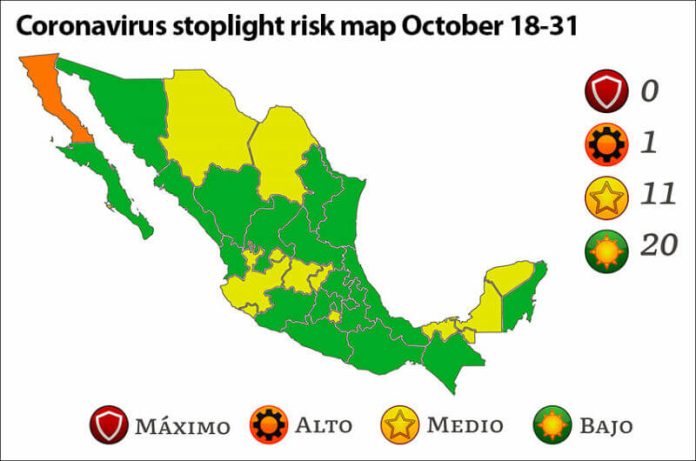Green once again dominates the federal government stoplight map. There are 20 states in the green, up from just nine two weeks ago. The new map has 11 yellow states, one orange and none in the red, and reflects the gradual recovery from the devastating third wave of COVID-19.
Mexico City and México state will switch to low risk green on the new map. The neighboring states, which rank first and second for coronavirus cases and COVID-19 deaths, will remain green until at least October 31. Both are medium risk yellow on the map currently in force.
Mexico City official Eduardo Clark said that case numbers and hospitalizations had decreased in the capital, although there are still more than 6,000 estimated active cases. The number of hospitalized COVID-19 patients in the greater Mexico City area declined to 1,450 from 1,705 a week ago, Clark said.
He said that bars, cantinas, nightclubs and other entertainment venues will be permitted to operate at 50% capacity until 1:00 a.m. starting Monday. There will be no limits on attendance at outdoor events.
Mexico City has been the country’s coronavirus epicenter since the start of the pandemic, and despite the imminent switch to green, still has more active cases than any other state in the country. However, the capital also has the nation’s highest vaccination rate, with more than 90% of adults inoculated against COVID-19.
![]()
Neighboring México state will also go green on Monday, Governor Alfredo del Mazo said. “In México state we’re making progress, … this has been possible thanks to the efforts of everyone,” he said in a video message.
The governor said that all economic and social activities that have not yet been permitted to resume will be able to do so starting Monday, albeit with restrictions. He noted that more than 80% of adult residents of the state are vaccinated with at least one shot, adding that all people aged 18 and over will have had the opportunity to get vaccinated by the end of the month.
The only orange state is Baja California. The yellow states are Chihuahua, Coahuila, Jalisco, Colima, Aguascalientes, Guanajuato, Querétaro, Morelos, Tabasco, Campeche and Yucatán.
In other COVID-19 news:
• The Health Ministry reported 5,825 new cases and 381 additional COVID-19 deaths on Thursday, lifting Mexico’s accumulated tallies to 3.74 million and 283,574, respectively. There are 40,835 estimated active cases across Mexico.
One in four cases recorded during the pandemic was detected in Mexico City and almost one in five deaths occurred there.
• Almost 67.7 million Mexican adults are vaccinated with at least one shot, according to the most recent Health Ministry data. Of that number, about three-quarters are fully vaccinated.
Mexico’s single-dose vaccination rate among adults is about 75% but just 53% if minors are counted.
• The federal government will wait until the first quarter of next year to consider the possibility of offering booster shots to adults, Health Minister Jorge Alcocer said.
“It’s possible but we don’t yet know the dynamic of the virus … in order to know when to reinforce [protection] or for which patients or individuals it’s recommended,” he said in an interview.
• Face masks became an instrument of “egotistical” people during the pandemic, Deputy Health Minister Hugo López-Gatell said during an appearance this week at an event at the International Book Fair in Mexico City.
“The idea of face masks became an instrument in which egotistical people, egotistical social groups, tried to blame others: ‘Put your face mask on because you are going to contaminate me and my little universe,’” he said.
“… In technical terms, we would have gotten better results if we had thought of face masks as a means of social connection, to protect one another.”
López-Gatell, the federal government’s coronavirus point man, was a less than forceful advocate for face masks at the beginning of the pandemic, casting doubt on their capacity to stop the spread of the virus.
With reports from Expansión Política, Milenio, AP, Reforma and El Universal
